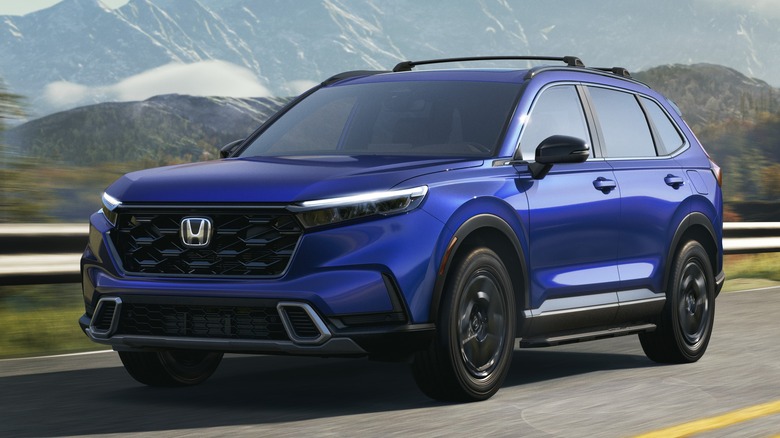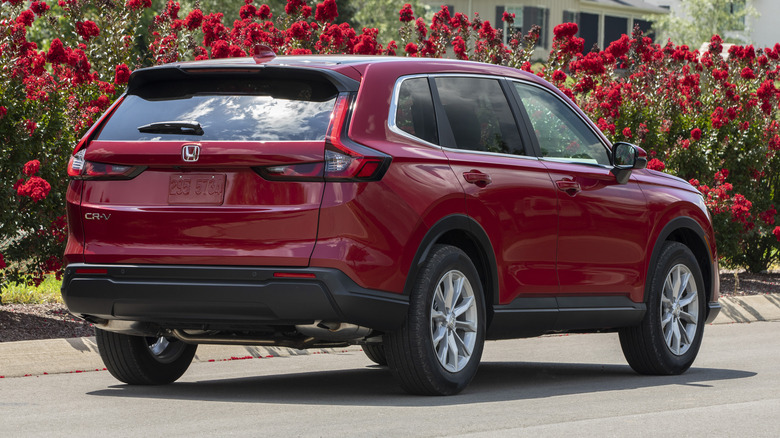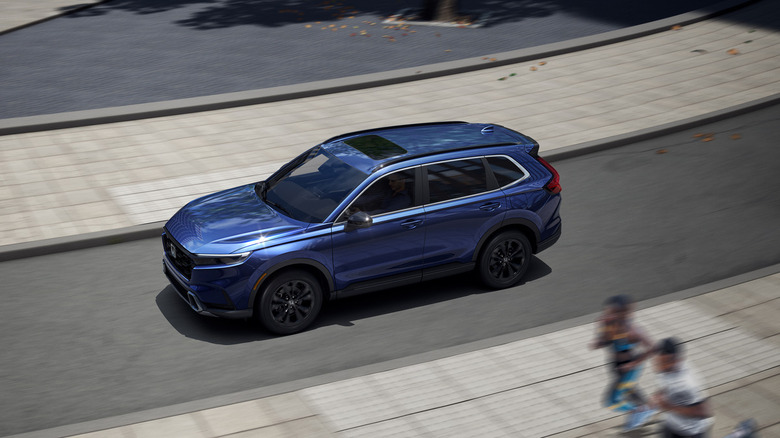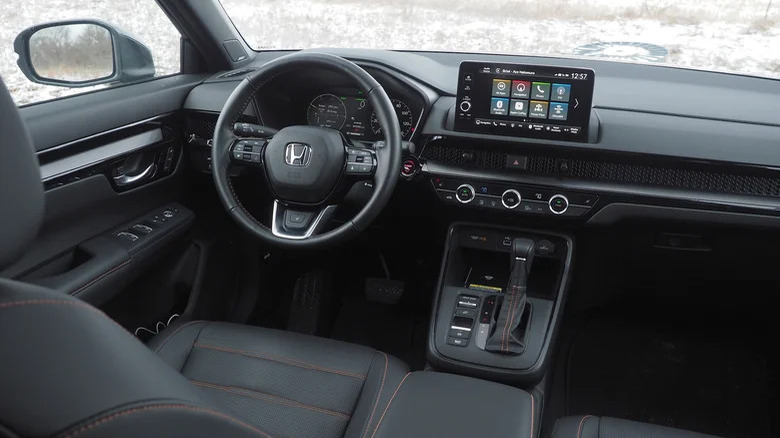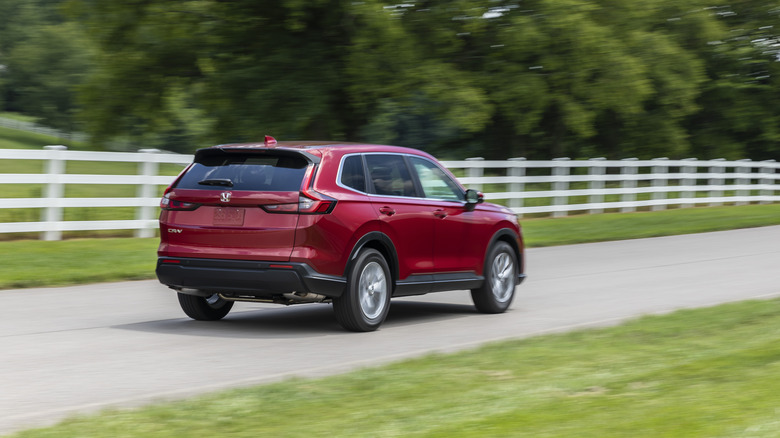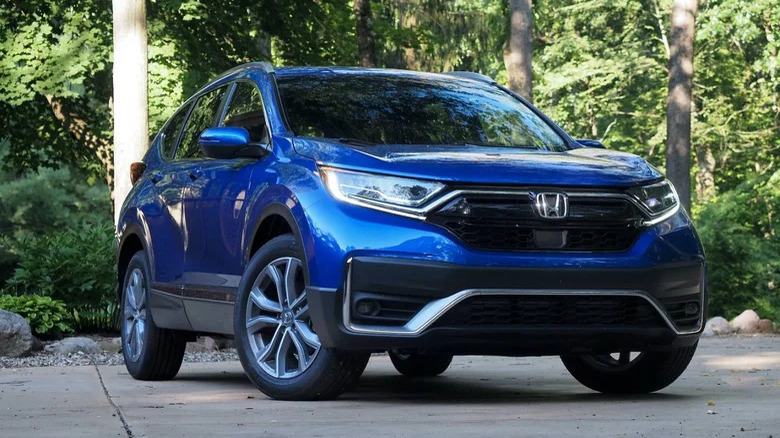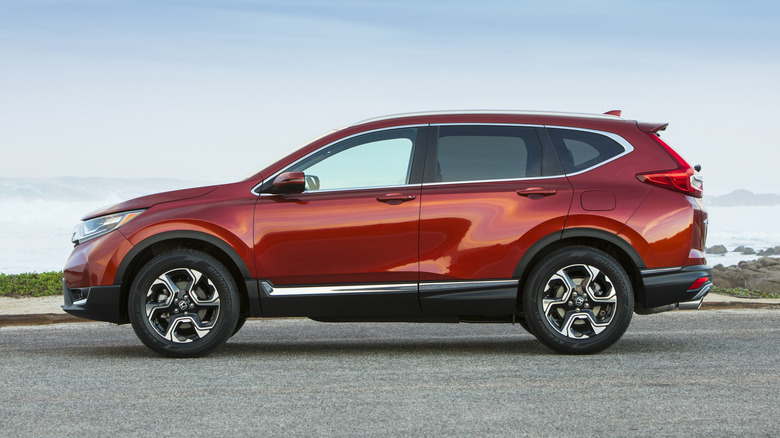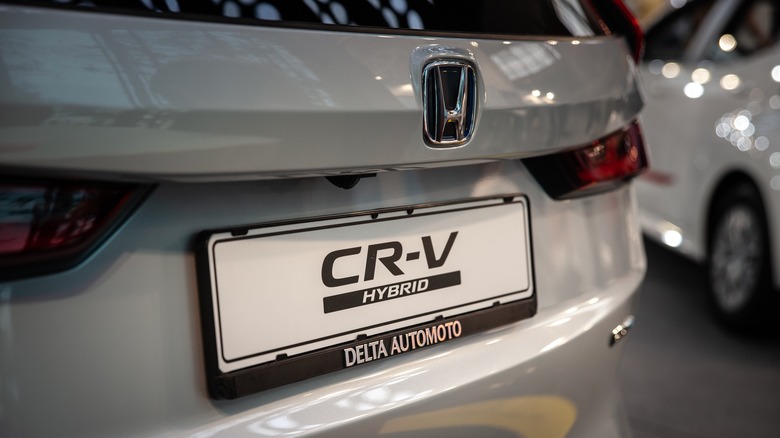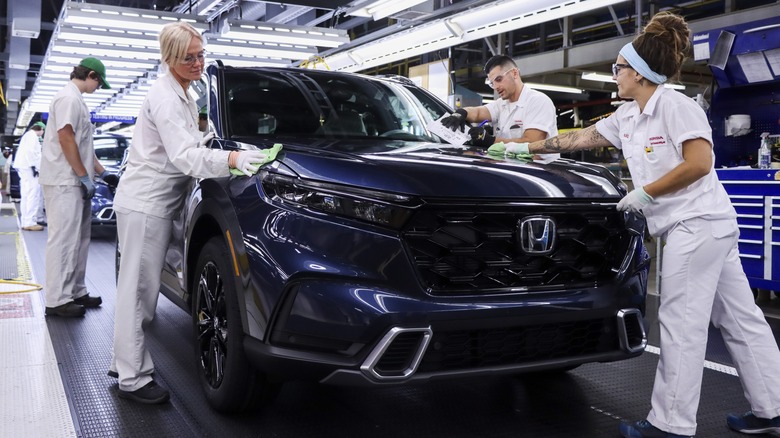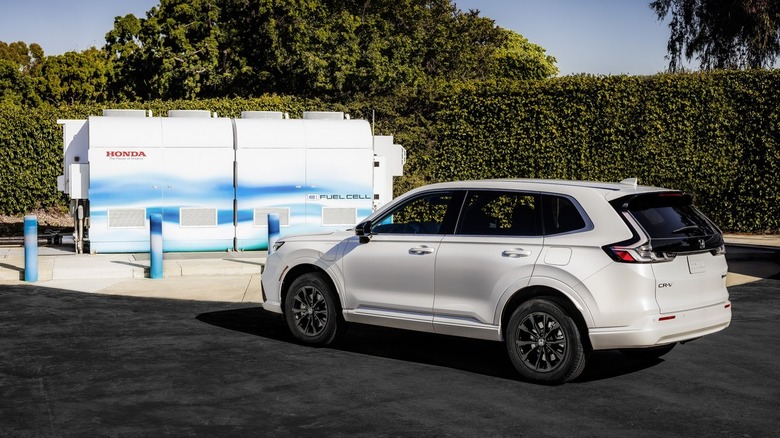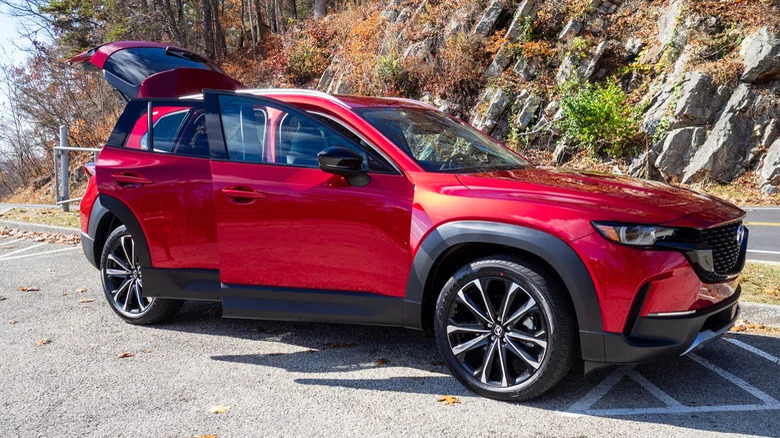10 Things You Should Know Before Buying A Honda CR-V (New Or Used)
The compact crossover segment is a tightly packed one, which makes the Honda CR-V's continued sales success all the more impressive. Honda sold more than 360,000 examples of the CR-V in the U.S. in 2023 according to CarFigures. That makes it comfortably the best-selling Honda SUV in its lineup, well ahead of the likes of the Passport and Pilot. The crossover's success is no accident — instead, it's down to Honda's winning combination of practicality, affordability, and safety, all of which remain in plentiful supply for both new and used examples of the CR-V.
This roundup of things to know before buying a CR-V draws from the expertise of SlashGear's review team and data from various trusted industry sources. The aim is to give buyers an overview of how the crossover compares to its competition, as well as how different CR-V model years compare with each other. For a more in-depth assessment of previous CR-V model years, be sure to check out SlashGear's hands-on reviews that are linked within the article below.
Both hybrid and non-hybrid powertrains are available
Data from the EIA shows a recent sharp rise in the sales of hybrid vehicles, with Q2 2024 sales increasing over 30% compared to last year. Hybrids are one of the fastest growing market categories, and that's great news for buyers that Honda offers both hybrid and non-hybrid options for the current generation CR-V. For 2025, the non-hybrid CR-V is only available with a turbocharged four-cylinder 1.5L engine making 190 horsepower. The only transmission available is a continuously variable transmission (CVT).
All hybrid CR-V models get a larger 2.0L engine paired with electric motors, which provides a combined 204 horsepower. Honda's E-CVT is the sole transmission option available. Front-wheel drive is standard across all trims apart from the top-spec Sport Touring, which is only available with all-wheel drive. For all other trims, all-wheel drive is available as an option for an additional $1,500.
The 2025 CR-V starts around $31,500
The base-spec 2025 CR-V LX starts at $31,450 including shipping fees, and for that, buyers get a front-wheel-drive car with minimal luxuries and the non-hybrid turbocharged 1.5L engine. The next step up in the range is the EX trim, which starts from $33,700 including fees and adds a power moonroof, a walk-away auto locking function, and heated front seats, among other extras. The lowest trim to be available with the hybrid powertrain is the Sport Hybrid, which is another step up in price again, at $35,700 including fees.
The EX-L is the most upscale trim available with the non-hybrid engine, featuring additions like leather interior trim and a power liftgate. It's available from $36,350 for 2025. The $38,700 Sport-L Hybrid offers a similar combination of upscale features but with the electrically-assisted powertrain, while the $42,150 Sport Touring Hybrid trim tops out the range. Various packages and accessories are also available at an extra cost, including a trailer hitch, fender flares, and even a tent.
The car was last overhauled for 2023
Unlike some other manufacturers, Honda doesn't tend to give its cars major updates every year or two. The last significant overhaul for the car was the 2023 model, which gained new styling, an updated cabin, and the latest safety tech, among other upgrades. Most of the new features were a net benefit in helping the crossover keep its crown as the segment benchmark, and served to improve what was already a highly competitive model in a packed segment.
However, after spending some time with the CR-V at the launch of the latest generation, SlashGear was not so impressed with all of its new safety tech. We found its lane departure warning system to be overly sensitive, with the system often falsely triggered by poorly marked lanes and rural roads. It quickly became annoying, and was one of the few downsides of what was otherwise a pleasant and comfortable week of testing.
Efficiency is competitive across both hybrid and non-hybrid trims
Alongside the sensitive lane departure system, another downside we noticed during our time with the car was that its real-world mpg figures were less than those advertised by Honda. They were, however, still largely competitive with what else is on offer in the CR-V's segment. According to the EPA, the 2025 non-hybrid CR-V achieves a rating of 28 mpg city, 34 mpg highway, and 30 mpg combined in front-wheel-drive form. Opting for all-wheel-drive knocks those figures down a little to 26 mpg city, 31 mpg highway, and 28 mpg combined.
The hybrid CR-V offers significantly higher EPA ratings, achieving 43 mpg city, 36 mpg highway, and 40 mpg combined in its most efficient front-wheel-drive form. Opting for all-wheel-drive results in official figures of 40 mpg city, 34 mpg highway, and 37 mpg combined. Our test vehicle was a CR-V Sport Touring Hybrid rated at an official combined 37 mpg, although our mixed test route saw an average of 30.4 mpg, notably less than the EPA estimate.
The previous generation CR-V is an appealing used pick
Buyers in the market for a used CR-V could consider either a 2023 or 2024 example of the current generation car, but looking further back is also worthwhile for those on a tighter budget. The previous generation CR-V launched for the 2016 model year, and at the time, SlashGear's reviewer gave the car an 8/10 rating. We found the car's practicality and comfort to be firmly among the best in class, concluding that "if you've got a family — or more going on in your life than you can stuff into a traditional four-door — it's tough find a more logical way to spend your money than on the CR-V."
A later review of the 2020 CR-V Touring delivered a similar verdict, although by that point, we felt the car's infotainment was becoming dated compared to what else was on offer in the segment. Still, the car's practical appeal remained unchanged, making the Honda a sensible choice even if it wasn't the most exciting car of its kind. Given the Japanese automaker's reputation for reliability and the high number of used examples available on the market, a used CR-V is also generally a safe bet. However, there are some model years that are worth avoiding for those looking to make sure their ownership is hassle-free.
Some model years have more complaints than others
Honda's reputation for reliability is hard-earned, and even its most troublesome models are generally still reliable overall. However, there are some notable quality blips in the CR-V's recent history, with the 2018 and 2017 models being the most complained about according to NHTSA data. A common complaint across both model years is that the forward collision avoidance system can activate unexpectedly, resulting in the car suddenly braking while on the road. The NHTSA has opened an investigation into the issue which remains ongoing at the time of writing.
Various other issues for the two model years have also been reported, including sudden loss of power accompanied by repeated warning lights and malfunctioning electrical systems. The 2018 and 2017 models are the most complained about by a significant margin, each having roughly 1,500 complaints to the NHTSA to date, but the 2019 model is also a poor performer, having logged over 750 complaints to date. The 2008 and 2007 model years are also among the worst for complaints, having logged 949 and 877 complaints respectively as of this writing.
The CR-V depreciates less than average
Anyone looking to sell their vehicle in the future, be that a new or used vehicle, should take depreciation into account when deciding what to buy. The longer you're planning to keep your car, the less it matters, but it's still always reassuring to have a car that holds its value well should your situation change and you end up needing to sell. The good news for CR-V buyers is that, on average, the car depreciates less than average, with KBB estimating that a 2024 model will lose 44.5% of its value over five years.
That's considerably less than the market average decline of roughly 60%. The CR-V's high value retention can be credited to several things, chief among them being the crossover's inherent practicality and Honda's long-standing reputation for reliability.
However, even with that reputation, it's always worth looking out for the common used car red flags when considering an older vehicle, especially if it appears to be cheaper than most other examples. Hondas might be reliable overall, but rusty, leaky, or badly maintained examples might still end up causing costly repair bills, as well as denting the car's future resale value.
The CR-V is built in both the U.S. and Canada
Honda produces most of its CR-Vs for the North American market in either the U.S. or Canada, with several plants responsible for churning out the latest generation of the car. Honda of Canada is the biggest producer of the CR-V, and has manufactured the model since 2012. In addition, two American Honda facilities, the Indiana Auto Plant and East Liberty Auto Plant in Ohio, also produce the model. Production capacity is reportedly split around 50-50 between the non-hybrid and hybrid CR-V.
The CR-V is just one of a long list of models that the automaker produces in America, with others including the Civic, Accord, Odyssey, Pilot, and most Acura models, among others. By its own estimates, 95% of the Honda automobiles sold in the U.S. were made in North America, putting Honda firmly among the top foreign manufacturers in terms of domestic car production.
A hydrogen powered CR-V is also available
It might be a niche offering thanks to the limited hydrogen infrastructure in America, but for buyers in areas where such infrastructure is available, Honda also offers the CR-V e:FCEV for 2025. It's a plug-in hybrid and so can run on either pure electric power or via a hydrogen fuel cell, giving it a combined range of 270 miles. The car also comes with $15,000 of complimentary fuel which can be used throughout the car's standard three-year lease period.
The car's electric-only range of 29 miles is enough to cover most drivers' grocery or school run, and the battery can be fully recharged in as little as 2.5 hours using a Level 2 home charger. The CR-V e:FCEV is Honda's first hydrogen-electric plug-in hybrid, and is only offered in California through a small network of dealers. It carries a base MSRP of $51,350 including fees, and is only available in front-wheel-drive form.
The CR-V is offered in a fiercely competitive segment
The CR-V might be a perennial bestseller, but it faces plenty of stiff competition. Among SlashGear's favorites is the Mazda CX-50, which offers more driver enjoyment than buyers might expect from the segment and an impressively upscale interior in its highest trims. It's not without its flaws — namely, the infotainment system lacks a touchscreen and it's not as efficient as its rivals — but it's certainly a strong contender and is offered at a similar price point to the CR-V.
The Toyota RAV4 is another top performer in the segment, lacking the driver engagement of the Mazda but making up for it in efficiency and reliability. Then, there are other options like the Hyundai Tucson, which impressed us with its distinctive styling and generous equipment levels but was let down by its uninspiring driving dynamics. It's worth considering the competition before opting for the CR-V, but the Honda still makes a compelling case for itself and will likely – and deservedly — remain a bestseller for the foreseeable future.
